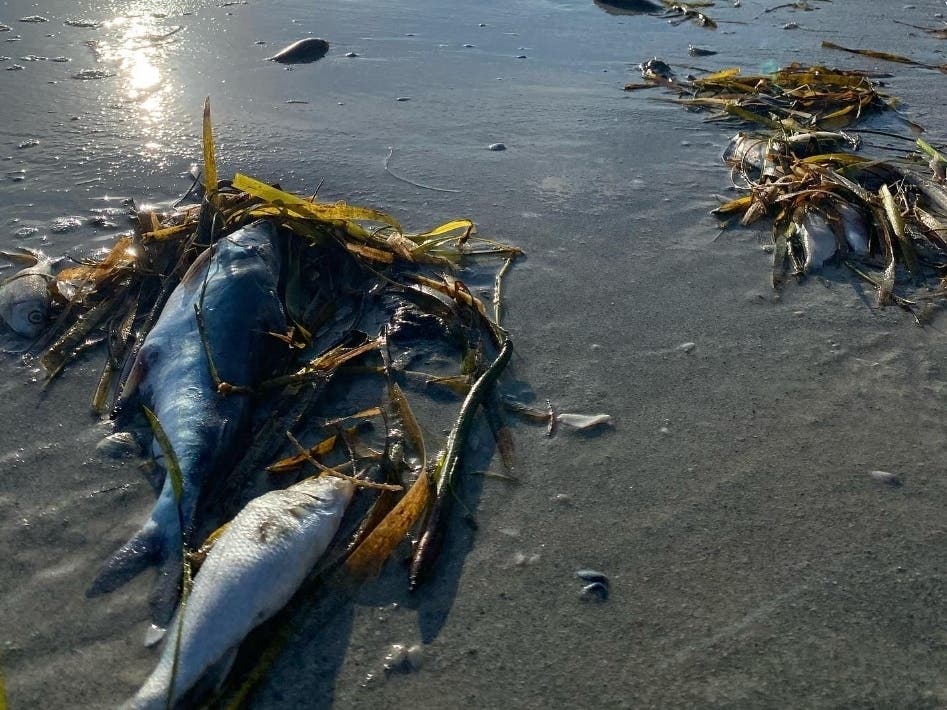Health & Fitness
Deaths Of Rare Sea Turtles, Manatees Attributed To Red Tide Toxin
Red tide conditions have now worsened along the Pinellas coast, resulting in the deaths of endangered manatees and sea turtles.

TAMPA BAY, FL — Following a brief period of improvement last weekend, Pinellas County officials say the red tide conditions have now worsened along the Pinellas coast, resulting in the deaths of threatened manatees and endangered sea turtles.
Pinellas County's water quality monitoring on Tuesday showed medium and high cell counts of K brevis, the organism that causes red tide, from Pass-A-Grille north to Honeymoon Island.
However, after cleaning up more than 3.4 million pounds of dead sea life and debris over the past month, the county didn't activate its cleanup contractor on Monday and Tuesday because there were no significant fish kills those days.
Find out what's happening in Clearwaterwith free, real-time updates from Patch.
Instead, marine biologists and conservationists were dismayed to see the red tide impacting some of Florida's most vulnerable sea life.
Sea Turtle Trackers, a group that patrols the beaches of St. Pete Beach and Shell Key Preserve, protecting sea turtle nests burrowed into the sands, said they found two dead juvenile Kemp's ridley sea turtles last week. Kemp's ridley sea turtles are the world's most endangered sea turtle species, according to National Geographic.
Find out what's happening in Clearwaterwith free, real-time updates from Patch.
The Florida Fish and Wildlife Conservation Commission also found nine manatees dead last week in red tide zones off the coasts of Pinellas and Hillsborough counties. The manatee is classified as threatened under the federal Endangered Species Act.
From Jan. 9 to July 22, the FWC said it has found 32 manatees dead in the red tide zone, which includes Lee, Charlotte, Sarasota, Pinellas and Hillsborough counties. So far, examinations have confirmed that nine died of red tide toxins. Two were killed by a boat strikes, and eight are too decomposed to determine the cause of death.
Related Story: Sharks Move Into Longboat Key Canals To Avoid Red Tide: Report
Between June 17 and July 22, 14 manatees were found dead in Hillsborough and Pinellas counties. Five are too decomposed to determine the cause of death. The FWC is awaiting the necropsy results on the rest.
Marine biologists at the Clearwater Marine Aquarium were so concerned about these statistics that they announced July 21 that they're fast-tracking plans to build a manatee rehabilitation center at Fred Howard Park in Tarpon Springs.
"I've never seen it this bad, and I've been studying manatees, believe it or not, for over 50 years," said Dr. James Powell, executive director of the aquarium's research institute.
Madeira Beach resident Nicole Morris of Save Florida's Beaches posted a video on the group's Facebook page this week that she said shows manatees pushing the carcass of a member of their aggregation near Indian Rocks Beach on July 23.
"The source who sent us this footage confirmed it was deceased and the others were pushing it around," she said. "I don’t have words right now. This has to change."
And it's not just manatees. Morris also posted a video on the group's Facebook page this week showing seven sick dolphins found in Madeira Beach inlets. She notified the Clearwater Marine Aquarium and the FWC.
"There were no live fish anywhere in sight and there is zero visibility in the water," she said. "They couldn’t breathe and were very lethargic."
Residents who had watched the dolphin's antics for years said they were devastated.
As of July 28, the FWC said there were no signs of red tide abating on the Pinellas coast and Tampa Bay and red tide health advisories remain in effect.
Over the past week, K. brevis was detected in 109 water samples with bloom concentrations of 100,000 or more cells per liter of water found in 59 samples: seven in Pasco County, 12 in Pinellas County, three in Hillsborough County, six in Manatee County, 27 in Sarasota County, two in Charlotte County and two in Lee County.
Bloom concentrations of 100,000 to 1 million are considered to be medium levels of red tide, and can cause respiratory irritation; shellfish harvesting closures and probable fish kills.
Concentrations over 1 million means red tide levels are high and can result in no-swimming warnings issued and beaches closed.
As of July 28, high concentrations were found in Clearwater Pass, Indian Shores, Treasure Island, Bay Dock in Sarasota Bay, Stump Pass Beach in Englewood, Nokomis Beach in Nokomis, Siesta Beach in Siesta Key, Turtle Beach in Sarasota, South Lido Park, La Contessa Pier in Redington Beach and Archibald Beach in St. Petersburg.
The National Oceanic and Atmospheric Administration red tide respiratory forecast tool indicates that people with respiratory conditions may have difficulty breathing at La Contessa Pier, Siesta Beach, Nokomis Beach and Turtle Beach.
Before heading to the beach, residents can check red tide conditions by clicking the FWC's daily sampling map or the Visit St. Pete/Clearwater beaches update.
See related stories:
- Record Deaths Of Manatees Prompt Urgent Need For New Rehab Center
- Manatee Deaths Surge In Florida, Experts Say Starvation Possible
- Red Tide Combined With Fish Kills Can Make Residents Doubly Sick
- High Levels Of Red Tide Detected In Hillsborough, Pasco Counties
- Rotten Fish Bodies From Red Tide Foul Bay, City Cleans Up
Get more local news delivered straight to your inbox. Sign up for free Patch newsletters and alerts.